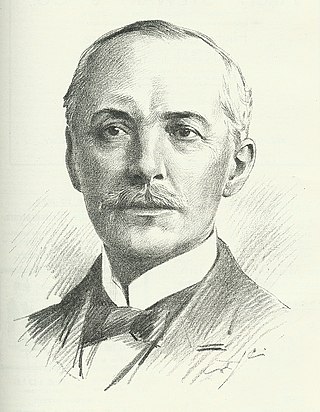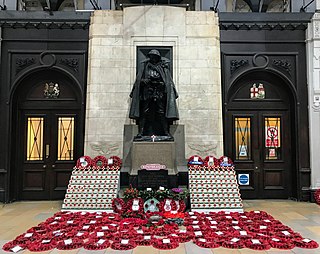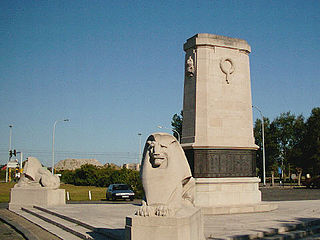
The Commonwealth War Graves Commission (CWGC) is an intergovernmental organisation of six independent member states whose principal function is to mark, record and maintain the graves and places of commemoration of Commonwealth of Nations military service members who died in the two World Wars. The commission is also responsible for commemorating Commonwealth civilians who died as a result of enemy action during the Second World War. The commission was founded by Sir Fabian Ware and constituted through royal charter in 1917 as the Imperial War Graves Commission. The change to the present name took place in 1960.

The Tower Hill Memorial is a pair of Commonwealth War Graves Commission memorials in Trinity Square Gardens, on Tower Hill in London, England. The memorials, one for the First World War and one for the Second, commemorate civilian, merchant seafarers and fishermen who were killed as a result of enemy action and have no known grave. The first, the Mercantile Marine War Memorial, was designed by Sir Edwin Lutyens and unveiled in 1928; the second, the Merchant Seamen's Memorial, was designed by Sir Edward Maufe and unveiled in 1955. A third memorial, commemorating merchant seamen who were killed in the 1982 Falklands War, was added to the site in 2005.

Badlu Singh VC was an Indian recipient of the Victoria Cross, the highest and most prestigious award for gallantry in the face of the enemy that can be awarded to British and Commonwealth forces.

Thomas Smith Tait was a Scottish modernist architect. He designed a number of buildings around the world in Art Deco and Streamline Moderne styles, notably St. Andrew's House on Calton Hill, Edinburgh, and the pylons for Sydney Harbour Bridge.

El Qantara is a northeastern Egyptian city on both sides of the Suez Canal, in the Egyptian governorate of Ismailia, 160 kilometres (99 mi) northeast of Cairo and 50 kilometres (31 mi) south of Port Said. The two parts of the city are connected by a high-level fixed road bridge, the Mubarak Peace Bridge. The bridge makes a connection between the division of Africa, and Asia, making El Qantara a Border town.

Heliopolis was an early 20th century suburb outside Cairo, Egypt, which has since merged with Cairo and is administratively divided into the districts of Masr El Gedida and El Nozha in the Eastern Area.

Sir John James Burnet was a Scottish Edwardian architect who was noted for a number of prominent buildings in Glasgow and London. He was the son of the architect John Burnet, and later went into partnership with his father, joining an architectural firm which would become an influential force in British Modern architecture in the 20th century.

Haydarpaşa Cemetery, also known as Haidar Pasha Cemetery, Istanbul,, located in the Haydarpaşa neighborhood of Üsküdar district in the Asian part of Istanbul, Turkey, is a burial ground established initially for British military personnel who took part in the Crimean War (1854–1856). The cemetery holds also graves of Commonwealth soldiers from the two World Wars, and civilians of British nationality.

Charles Sargeant Jagger was a British sculptor who, following active service in the First World War, sculpted many works on the theme of war. He is best known for his war memorials, especially the Royal Artillery Memorial at Hyde Park Corner and the Great Western Railway War Memorial in Paddington Railway Station. He also designed several other monuments around Britain and other parts of the world.

The Great Western Railway War Memorial is a First World War memorial by Charles Sargeant Jagger and Thomas S. Tait. It stands on platform 1 at London Paddington station, commemorating the 2,500 employees of the Great Western Railway (GWR) who were killed in the conflict. One-third of the GWR's workforce of almost 80,000 left to fight in the First World War, the company guaranteeing their jobs, and the GWR gave over its workshops for munitions manufacturing as well as devoting its network to transporting soldiers and military equipment. The company considered several schemes for a war memorial before approaching Jagger to design a statue. Some officials continued to push for an alternate design, to the point that Jagger threatened to resign. Jagger was working on several other war memorial commissions at the same time as the GWR's, including his most famous, the Royal Artillery Memorial.

The Anglo-Belgian War Memorial is a monument in Brussels, Belgium, which was commissioned by the British Imperial War Graves Commission and designed by the British sculptor Charles Sargeant Jagger. Unveiled in 1923 by the Prince of Wales, it commemorates the support given by the Belgian People to British prisoners of war during the First World War. It is located on the Place Poelaert/Poelaertplein near Brussels' Palace of Justice and the Belgian Infantry Memorial.
Tell El Kebir is 110 km north-north-east of Cairo and 75 kilometres south of Port Said on the edge of the Egyptian desert at the altitude of 29 m. Administratively, it is a part of the Ismailia Governorate.

The Cambrai Memorial to the Missing is a Commonwealth War Graves Commission (CWGC) memorial for the missing soldiers of World War I who fought in the Battle of Cambrai on the Western Front.

The British Nieuport Memorial is a First World War memorial, located in the Belgian port city of Nieuwpoort, which is at the mouth of the River Yser. The memorial lists 547 names of British officers and men with no known grave who were killed in the Siege of Antwerp in 1914 or in the defence of this part of the Western Front from June to November 1917. Those that fought in 1914 were members of the Royal Naval Division. The fighting in 1917, when XV Corps defended the line from Sint-Joris to the sea, included the German use of chemical weapons such as mustard gas and Blue Cross.

The Buttes New British Cemetery Memorial is a World War I memorial, located in Buttes New British Cemetery, near the town of Zonnebeke, Belgium. It commemorates 378 officers and men of the New Zealand Division who were killed in the vicinity and have no known grave.

The Alamein Memorial is a Commonwealth War Graves Commission war memorial in the El Alamein War Cemetery, El Alamein, Egypt. The memorial commemorates 11,866 Commonwealth forces members who died during World War II. The memorial was designed by Hubert Worthington and unveiled by Viscount Montgomery of Alamein on 24 October 1954.

The Basra Memorial is a Commonwealth War Graves Commission war memorial near Zubayr, Iraq. The memorial commemorates 40,682 Commonwealth forces members who died during the Mesopotamian Campaign, from the Autumn of 1914 to the end of August 1921, and whose graves are not known. The memorial was designed by Edward Prioleau Warren. It was unveiled by Gilbert Clayton on 27 March 1929. Originally located eight kilometres north of Basra, near the Shatt al-Arab River, it was moved southwest in 1997 to a battleground from the much more recent Gulf War.
Heliopolis War Cemetery, which includes two relocated memorials - the Heliopolis Memorial and the Heliopolis (Aden) Memorial, is a war cemetery & memorial in the Heliopolis district of Cairo in Egypt for Commonwealth personnel of British Indian Army who died in World War I (WWI) and World War II (WWII). Of the 4,000 personals buried or commemorated here, 3727 are Indians - of whom nearly 2000 died in WWI and 1700 died in WWII.

The City of Portsmouth War Memorial, also referred to as the Guildhall Square War Memorial, is a First World War memorial in Guildhall Square in the centre of Portsmouth, Hampshire, on the south coast of England. Portsmouth was and remains a port and home to a major naval dockyard. The dockyard and the armed forces provided much of the employment in the area in the early 20th century. As such, the town suffered significant losses in the First World War. Planning for a war memorial began shortly after the end of the conflict and a committee was established for the purpose. It selected a site adjacent to a railway embankment close to the Town Hall and chose the architects James Gibson and Walter Gordon, with sculptural elements by Charles Sargeant Jagger, from an open competition.

















